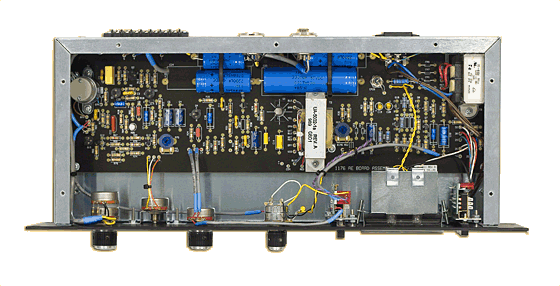
Analog Obsession: The 1176AE Anniversary Edition
By Will Shanks
What makes the 1176 the most recognized limiter ever made, and why is it as popular now as it was when first conceived over 40 years ago? What makes the various revs unique? Universal Audio asked themselves these questions and more in the development of the 1176 AE Anniversary Edition, the latest generation of the legendary tool.
 |
| Behold the limited-run 1176AE. |
The 1176AE Anniversary Edition is a custom, limited-run, “hod-rodded” version of the world’s most recognized studio limiter.
 |
| Click to see a detailed photo of the 1176AE's internal cosmetic treatments. |
Celebrating a decade of Universal Audio’s re-founding, and just over 40 years since the birth of the 1176, the 1176AE Anniversary Edition is a custom, limited-run, “hod-rodded” version of the world’s most recognized studio limiter. Only 500 1176AE units will be made available worldwide. Why would we do such a thing? Most agree that the Rev D/E 1176LN units are the pinnacle of the 1176 revisions. (The only difference the addition of the 110/220 voltage-select switch.) But there are those who disagree, and find that their favorite is the “bluestripe revision.” The “AE” descriptor not only stands for Anniversary Edition, but along with its blackface/bluestripe cosmetic treatment signifies the very unit revisions from which this unique instrument draws.
 |
| 1176 Revision A/B, serial #141 (the 40th 1176 ever made) |
While some bluestripe fans believe that the bluestripe sounds better because it lacks LN circuitry, some myths were busted in the conception of the AE. To be sure, when put on a bench, the only sonic difference from adding or removing the LN circuitry was a reduction or increase in noise floor! But with further exploration of the 1176 rev A, A/B and B, we discovered that a deliberate electronics modification was made to change the program dependent characteristics at rev C. This gave the unit subtly different compression characteristics, and therefore a different sound—UA believes this is the biggest sonic difference in the bluestripes. No record remains of this change, other than the schematic itself, with no recorded reason for the change. The 1176AE borrows the sonically unique, program-dependent characteristics from the original Revision A “Bluestripe” while retaining the class-A, low-noise (“LN”) circuit and custom transformers of the most popular 1176LN Revision D/E—who would want more noise? Of course, the 1176AE also retains all the other iterative changes that made the revision E the pinnacle in 1176 revisions.
 |
| Revision E unit, from UA’s history rack |
Giving the product another sonic distinction, the ratio selections hearken back to the 1176’s predecessor, the UA 176 Limiting Amplifier. The 1176AE offers a gentler ratio array of 2:1, 4:1, and 8:1, perfect for compression duties—a unique change making the 1176AE useful for vocal tracking and other situations where a low ratio is preferred. The unit also preserves 20:1 at the top, for full limiting applications, for which the 1176 is famous. (We determined that 12:1 was likely the least used of the original ratios.)
 |
| UA’s newly acquired 176 Limiter with the selectable (2:1, 4:1, 8:1, 12:1) ratio |
This ratio modification also allows for a unique range of multi-button ratio combinations, pushing the unit beyond the famous “all-button” mode of the standard unit. While the original unit could achieve other multi-button combinations, the 1176AE has a much more audible difference with various combinations. Note however that the “all-button” sound we’ve all come to know and love on the original is achieved differently: In the case of the 1176AE, the top THREE ratios should be pressed in.
Lastly, the 1176AE offers something new for bass-heavy tracks or “over-the-top” effects, with a unique “super-slow” attack setting of 10 ms, cleverly repurposed from the redundant Off/Bypass position from the 1176’s Attack control. This gives the user an option not achievable with the original unit, allowing transients to pass more freely—again furthering the versatility of the 1176AE beyond its predecessors. Say goodbye to 1176 bass roll-off! Specifically with a slower attack (the original 1176 is famous for the fastest attack times in the business), a drum loop will pass much more low frequency information, as will bass instruments. Also, a slower attack translates to a greater ability to “mangle” certain source material. Check out these comparative clips:
Download the zip file. Five files are included, all AIFF at 24/44.1. The source, a kick drum mic on a full kit.
“Uncompressed” is the untreated file.
“800 micro attack” demonstrates compression at the new, gentler 2:1 ratio, with the fastest release and slowest attack without the “Slo” mod—a nice moderate use of the 1176AE, with around 5 dB of gain reduction.
“10ms attack” duplicates the previous settings but with the “Slo” 10millisecond mod engaged, allowing the low frequency transient from the kick drum to pass much more freely, while focusing on the rest of the drums.
“Top 3 ratios” shows the 1176AE in classic “All-Button” mode—remember that with the 1176AE, instead of all four, just the top three ratios should be engaged to achieve the identical sound. Attack is at its fastest, while release is moderate (and timed to the tempo) at 12 o’clock. Plenty of Input was used to achieve a high level of compression distortion. (All-Button essentially throws the unit out of calibration, causing all sorts of artifacts)
“Bottom 3 ratios” duplicates the previous settings, but with one of the other various ratio combinations—the bottom three ratios are engaged here. In this case, the sound is similar to the “All-Button” attack and release characteristics, but has less audible compression distortion—a useful and previously unattainable sound from any 1176.
What makes each 1176 revision unique? The full scoop is found in this previous UA Webzine article.